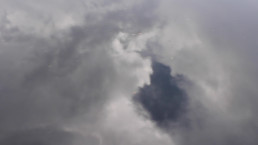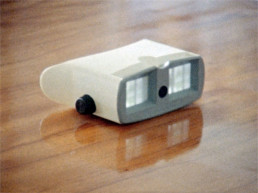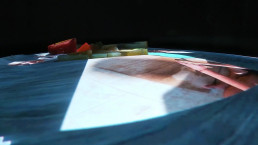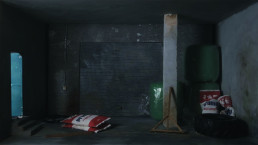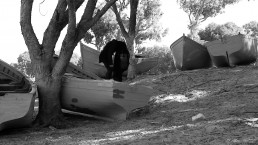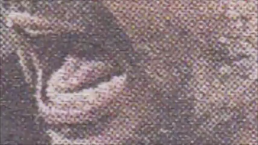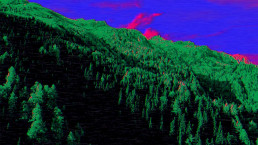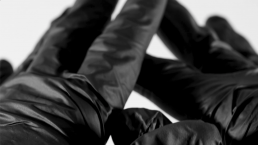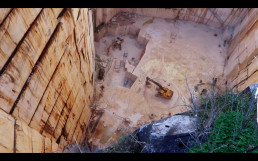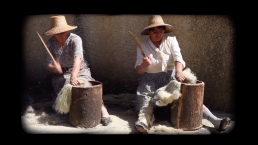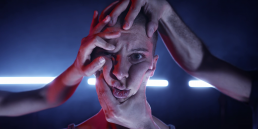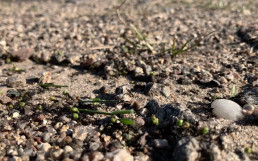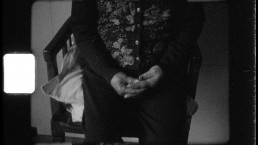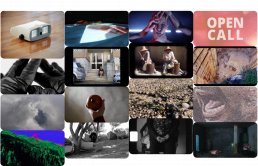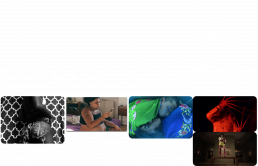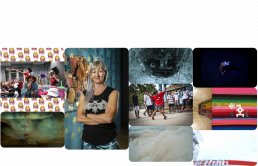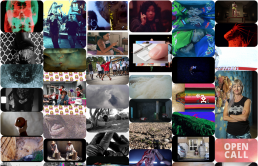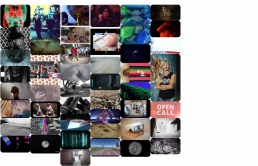“FUSO 2021 – 25 a 29 de Agosto
25 Agosto, 22h00 MAAT
Museu de Arte, Arquitetura e Tecnologia
Open Call
Seleção de Jean-François Chougnet
Sobre uma seleção
Nunca na já substancial história do FUSO – anual de videoarte internacional de Lisboa, o número de participantes foi maior: mais de 200. Esta é, para além da qualidade necessariamente variável dos filmes, a prova da vitalidade da criação em Portugal.
Pode-se pensar que neste ano de 2021 haverá um aumento no número de “obras de confinamento”. No entanto, esta categoria está, à primeira vista, totalmente ausente das propostas. Numa primeira análise, porque se voltarmos a olhar para eles, se o confinamento não é um assunto, os temas escolhidos muitas vezes estão ligados com a relação com o mundo, com o meio ambiente, temas que a pandemia covid-19 tornou mais significativas e mais angustiantes do que nunca.
Salvo raras exceções, o humor que rendeu às edições anteriores algumas grandes propostas está totalmente (ou quase) ausente deste panorama subjetivo que o Fuso desenha aos nossos olhos.
A pesquisa puramente formal também, como se o estado do mundo empurrasse os criadores (de todas as gerações, convém lembrar, dos 20 aos 60 anos) a uma certa urgência, a um certo imediatismo.
É, portanto, a prestar atenção à fabricação de imagens e às vezes à possível reciclagem delas que esses artistas nos convidam. Como disse recentemente o videoartista alemão Hito Steyerl, “já existem tantas imagens que muitas vezes não há necessidade de fazer novas. Muitas das imagens produzidas hoje são desnecessárias. “
Jean-François Chougnet
Bruno Carnide PT – Equinox 3’28’’ 2019
Algures nos subúrbios de Tóquio, sempre que os dias são iguais às noites, o amor perde mais uma batalha.
Cristina Ataíde – Rio Negro 8’14’’ 2020
Realizado, durante a residência artística LABVERDE- Art Immersion Program in The Amazon em Agosto de 2019, este vídeo resulta de um profundo fascínio pelo momento de encontro das águas dos Rios.
Durante 5 dias, subimos o Rio Negro e o serpenteante Rio Cuieiras. As suas águas coloridas de castanho escuro, avermelhado, e as misturas de azul que refletiam o céu, de forma tão espelhada que resultaram num efeito de simetria onde o único momento de perceção do espaço seria a linha de horizonte. Essa fusão simulada do espaço, leva-os a pensar a realidade como um simulacro de efeitos e fenômenos óticos em que o vídeo pode reproduzir por momentos, a experiência do “Lugar” .
Durante a noite, percorria os trilhos, sozinha, gravei as sonoridades da floresta envolvente, povoada por seres quase sempre invisíveis, numa experiência emocional, criada por sons riquíssimos e arrebatados.
Entre as fronteiras do visível e do invisível, este vídeo é uma pequena interpretação de uma experiência inesquecível de um lugar no mundo onde uma floresta está a ser sistematicamente destruída pelo Homem e de um rio, fronteira da Natureza, sempre em constante mutação.
Eduardo Brito – La Ermita 4’10’’ 2021
Uma voz interpela o viajante: tu nunca foste a La Ermita, mas eu tenho a certeza que já lá estiveste. Quando?
Ema Ramos – Sempre achei que fosse uma pessoa de Cidade 1’26’’ 2021
Uma reflexão dos últimos dois anos, a mudança de acabar o secundário, sair da adolescência e da Covid-19.
Francisco Miguel – Quelimane 4’08’’ 2019
Será a imagem em movimento capaz de nos aproximar de um espaço que desconhecemos? Pode o vídeo funcionar como um meio de transporte? É em Quelimane que Francisco Miguel espelha o seu imaginário, cidade de onde provém a sua família mas cuja nunca teve oportunidade de visitar. Através da simbiose plástica e motora da imagem com o som, Quelimane é uma sinfonia visual que abraça a experimentação e a possibilidade como passo em frente e questiona as fronteiras que o vídeo consegue ultrapassar.
Grégory Le Lay – Milk shake 3’28’’ 2020
Como é que o homem organiza, constrói, adapta um território às suas necessidades humanas ou, pelo menos, às necessidades económicas?
A indústria leiteira que tem um forte impacto na paisagem açoriana é a base estruturante do projeto. MILK SHAKE é um olhar crítico sobre essa atividade onde não existem “vacas felizes”, sobre a instrumentalização corporal, a inflação e a realidade económica.
Ideas and feelings about identity are located in the specificities of places and landscapes in what they actually look like or perhaps more typically how they ought to appear. from “Representations in guidebooks, postcards, tourist brochures and so on” (Tilley, 2006, pg. 14)
Azorean industries, particularly those involved in processing milk, have been negatively affected after the Arquipélago became part of the European Union. Milk quotas have limited production and milk products from Spain and France have become string competitors in the local market
(Costa, 2008, pg. 299)
A linha de montagem não faz a diferença ontológica entre merda e creme.
(Anônimo, 2020)
Helena Inverno, Verónica Castro e Bouchra Ouizguen – Transhumance 7’14’’ 2019
A partir de um sistema de acção transdisciplinar em corpo nómada, TRANSHUMANCE junta léxicos, co-habita pesquisas, partilha caminhos – formando um ponto de encontro entre três artistas imersas nas suas práticas correntes, onde confluem dança, som e imagem em movimento.
Polinizam-se conteúdos, matérias e sensações; enquanto rio, vento, dunas, e um pássaro e uma pedra, respiram.
Nuno Nunes-Ferreira – Café Central 3’ 2021
2500 recortes de jornais em 3 minutos.
Paula Albuquerque – Wash. Rinse. Repeat. 8’25’’ 2020
Montagem de imagens térmicas, incluindo as geradas por drones bélicos e de vigilância, algumas delas criadas por equipamento defeituoso, acompanhada pela voz do narrador lendo uma carta escrita por um drone sensor a uma professora do MIT.
Pedro Calapez – Entremãos 5’1’’ 2021
as mãos discutem, hesitam, questionam como contactamos.
Renata Bueno – Coreografia numa Pedreira 1’18’’ 2021
Trabalhadores e máquinas de uma pedreira mudam por instantes sua rotina e junto com a artista desenham no espaço uma coreografia nunca por eles imaginada.
Sally Santiago – O caminho ao até 4’48’’ 2020
O vídeo ‘O caminho ao até’ surge no final de 2020 pela parceria e proposta de criação a partir de arquivo, com o projeto cultural Binaural Nodar.
Os arquivos que compõe o projeto atuam de forma ilustrativa à narrativa apresentada por meio de uma voz que acompanha o vídeo, ao desafiar de certa forma fronteiras humanas contemporâneas no abordar da valorização de processos vividos ao longo da vida—processos que geram aprendizado— em contraste a valorização única dos resultados alcançados, os aprendizados já “digeridos”. Estabelecendo uma passagem subconsciente entre um viver automático e ansioso para um viver de lentidão e de apreciação no presente.
Os arquivos utilizados neste projeto retratam o processo passo a passo da confecção do linho na região de Viseu, desde o seu cultivo até à tecelagem, ultrapassando fronteiras materiais que contribuem de forma contextual à fronteiras de evolução humanas. Onde pode-se então observar de forma simultânea a realização de um processo manual e assim também ouvir/refletir sobre um processo —muitas vezes subjetivo— de revalorização.
O texto que acompanha de forma audível o decorrer da reflexão anseia pelo encorajar e questionar do caminhar e aprender —em conjunto—, e exalta o caminho até a conclusão de algo em nossas vidas, podendo ser encarado como a valorização do presente e do agora assim como o futuro e o alcance é valorizado.
Sara Bernardo – Breathe a Little Bit Faster, now! 5’53’’ 2021
Breathe a Little bit faster, now! | 1984 é inspirado no livro “1984”, de George Orwell, onde é apresentada a ideologia e forma de viver num lugar de guerra oprimido, vigiado, sem liberdade de expressão ou de pensamento.
Esta videodança para três intérpretes toca nas ideias de vigilância e de opressão, variando desde a percepção de estarmos constantemente a ser observados, até ao extremo oposto da opressão física e subsequente conformismo do oprimido. O ambiente é negro, acinzentado de guerra.
Recriando o ambiente vigilante de “1984”, recorremos ao suporte de vídeo, trazendo para o ecrã as ações e as emoções mais profundas de cada personagem. A auto e hétero censura e a construção de personagens que sabem estar a ser observadas fazem parte da dramaturgia, assim como o que se passa “por detrás das câmaras”- a exposição crua de um ser na sua intimidade.
Todas estas questões são exploradas, transformando-se numa narrativa onde os corpos se movem em conjunto e se interpelam, onde harmoniosamente, ou não, coabitam um espaço e encontram formas de escapar dos outros e de eles próprios.
Sofia Arriscado e Costanza Givone – Lapso 9’24’’ 2021
“Lapso” é o espaço da dúvida e o tempo no qual as fronteiras que separam o interior e o exterior do corpo entram em queda. Um mergulho onírico na realidade deixa-nos furar o corpo e chegar às camadas mais profundas, onde a intimidade e a partilha deixam as vísceras à mostra e as barreiras à superfície.
Susana Anágua – The Factory (bad Machines) 2’17’’ 2019
“The Factory (bad Machines)” 2019, é um vídeo realizado numa pequena praia na cidade de Colónia Del Sacramento no Uruguai após ter atravessado o Rio del la Plata vinda de Buenos Aires na Argentina.
Fronteiras físicas que se tornaram metáforas através de uma imagem de formigas frenéticas também elas em travessia do espaço. Na edição fez sentido juntar alguns dos diálogos do filme Midnight Express (1978) de Alan Parker.
Pode o comportamento de um homem ser comparado ou mesmo explicado por um fenômeno físico e científico como a entropia?
Em 1978, Alan Parker dirigiu o filme de sucesso intitulado “Midnight Express” e num determinado momento do filme, um homem é condenado a 4 anos de prisão na Turquia por uso e posse de drogas que seriam legalizadas noutro país. Numa das cenas a personagem, Billy, é colocada no pan-óptico da prisão onde todos circulam no sentido horário ao redor de uma roda.
Billy começa a andar contra o fluxo, esbarrando com todos que vêm na direção oposta, mesmo quando um outro preso o tenta persuadi-lo de que está errado.
Da ordem ao caos, as fronteiras geográficas e humanas são sugeridas neste vídeo pelo movimento das formigas, pequenos insetos trabalhando numa fábrica na hora de ponta, como na metáfora do filme se alguma formiga circular no sentido contrário ela vai estabelecer a desordem, aumentar o esforço da comunidade e aumentar o valor de Entropia.
“FUSO 2021 – August 25th to 29th
August 25th, 10pm MAAT
MAAT – Museum of Art, Architecture and Technology
Open Call
Selection by Jean-François Chougnet
About a selection
Never in the already substantial history of FUSO – Lisbon International Video Art Festival, the number of participants was higher: more than 200. This, in addition to the necessarily variable quality of films, is proof of the vitality of creation in Portugal.
One might think that in this year 2021 there would have been an increase in the number of “confinement works”. However, this category is, at first glance, totally absent from the proposals. At first glance, because if we look at them again, if confinement is not a subject, the themes chosen are often connected with the relationship with the world, with the environment, themes that the Covid-19 pandemic has made more significant and more distressing than ever.
With rare exceptions, the humour that earned the previous editions some great proposals is absent (or almost) from this subjective panorama that FUSO brings to our fruition. The same applies to the purely formal research, as if the state of the world pushed the creators (of all generations, it should be noted, from the age of 20 to 60) to a certain urgency, to a certain immediacy.
It is, therefore, to pay attention to the manufacture of images and sometimes to the possible recycling of them that these artists invite us. As German video artist Hito Steyerl recently said, “there are already so many images that there is often no need to make new ones. Many of the images produced today are unnecessary.
Jean-François Chougnet
Bruno Carnide PT – Equinox 3’28’’ 2019
Somewhere on the outskirts of Tokyo, whenever the days are as long as the nights, love loses yet another battle.
Cristina Ataíde – Rio Negro 8’14’’ 2020
The Video was made during the residency LABVERDE – Art Immersion Program in the Amazon area in August 2019. Those moving images are the result of a deep fascination for the moment where the waters of the Rio Negro and Solimões Rivers cross.
For 5 days, the group of artists and locals traveled the Rio Negro and the meandering Rio Cuieiras.
It’s dark brown, reddish coloured waters, and mixtures of blue that reflected the sky, in such a mirrored way that they resulted in an effect of symmetry where the only moment of perception of space would be the horizon line. This fusion of space leads them to think of reality as a simulacrum of optical effects and phenomena in which the video can briefly reproduce the experience of “Place”.
During the night, I walked the trails, alone, I recorded the sounds of the surrounding forest, populated by beings almost always invisible, in an emotional experience, created by rich and enraptured sounds. Between the borders of the visible and the invisible, this video is a brief interpretation of an unforgettable experience of a place in the world where the forest is being systematically destroyed by Man, and a river as the frontier of Nature, always in constant mutation.
Eduardo Brito – La Ermita 4’10’’ 2021
A voice asks the traveller: you’ve never been to La Ermita, but I am sure you’ve been there. When?
Ema Ramos – Sempre achei que fosse uma pessoa de Cidade 1’26’’ 2021
A reflection of the past two years, the change of finishing High School, stop being a teenager and the Covid-19 pandemic.
Francisco Miguel – Quelimane 4’08’’ 2019
Can video bring us closer to a space that we do not know? Can video making function as a transport? Francisco Miguel explores this question while reflecting about Quelimane – the city where his family comes from but that he never had the opportunity to visit. Through the shared values and possibilities that emerge when video and music come together, Quelimane is a visual symphony that embraces experimentation as a step forward towards the unknown.
Grégory Le Lay – Milk shake 3’28’’ 2020
How does man organize, construct, adapt a territory to his human necessities or at least to economic necessities?
The milk industry, which has a strong impact on the Azorean landscape, is the structuring basis for the project. MILK SHAKE is a critical view of that activity in which there are no “happy cows vacas”, on bodily instrumentalization, inflation and economic reality.
Ideas and feelings about identity are located in the specificities of places and landscapes in what they actually look like or perhaps more typically how they ought to appear. from “Representations in guidebooks, postcards, tourist brochures and so on” (Tilley, 2006)
Azorean industries, particularly those involved in processing milk, have been negatively affected after the Archipelago became part of the European Union. Milk quotas have limited production and milk products from Spain and France have become strong competitors in the local market. (Costa, 2008)
The editing line does not differentiate the ontology between shit and cream.
(Anonymous, 2020)”
Helena Inverno, Verónica Castro e Bouchra Ouizguen – Transhumance 7’14’’ 2019
Based on a system of transdisciplinary action in a nomadic body, TRANSHUMANCE brings together lexicons, cohabits research and shares paths, forming a meeting point between three artists immersed in their current practices, where dance, sound and moving image converge.
Content, materials and sensations are pollinated; while the river, wind, dunes, and a bird and a rock, breathe.
Nuno Nunes-Ferreira – Café Central 3’ 2021
2500 newspaper clippings in 3 minutes.
Paula Albuquerque – Wash. Rinse. Repeat. 8’25’’ 2020
A montage of thermal imagery, including that generated by armed and surveillance drones, some of them originating from defective equipment, accompanied by a narrator’s voice reading a letter written by a drone sensor to an MIT professor.
Pedro Calapez – Entremãos 5’1’’ 2021
Hands discuss, hesitate, question how we communicate.
Renata Bueno – Coreografia numa Pedreira 1’18’’ 2021
Workers and machines in a marble quarry change their routine for a glance and together with the artist they draw a choreography they never imagined in that space.
Sally Santiago – O caminho ao até 4’48’’ 2020
The video ‘O caminho ao até’ was made at the end of 2020 by the partnership and proposal of creation from an archive, with the cultural project Binaural Nodar.
The files that make up the project act in an illustrative way to the narrative presented through a voice that accompanies the video, while somehow challenging contemporary human frontiers in addressing the valuation of processes experienced throughout life—processes that generate learning—in contrast to the unique appreciation of the results achieved, the learning already “digested”. Establishing a subconscious passage between an automatic and anxious living to a living of slowness and appreciation in the present.
The files used in this project portray the step-by-step process of making linen in the region of Viseu, from its cultivation to weaving, crossing material frontiers that contribute in a contextual way to the frontiers of human evolution. Where one can then simultaneously observe the performance of a manual process and thus also hear/reflect on a —often subjective— process of revaluation.
The text that audibly accompanies the course of the reflection yearns to encourage and question the journey and learning —together—, and exalts the path to the conclusion of something in our lives, which can be seen as the appreciation of the present and the now, as well as the future and reach is valued.
Sara Bernardo – Breathe a Little Bit Faster, now! 5’53’’ 2021
Breathe a little bit faster, now! | 1984 is inspired by George Orwell’s book “1984”, where the ideology and way of living are presented in an oppressed warzone, a censored dystopian universe.
This video dance piece for three performers touches the ideas of vigilance and oppression, ranging from the perception of constantly being observed, to the opposite extreme of physical oppression and subsequent conformism of the oppressed. The environment is black, grayish of war.
Recreating the watchful environment of “”1984″”, we resort to video support, where we bring to the screen the deep emotions and actions of each character. The self and peer-censorship and the construction of characters who know that are being observed is part of the dramaturgy, as well as what goes on “”behind the camera””- the raw exposition of a being in its intimacy.
All these questions are explored, transforming into a narrative where bodies move together and interchange, where harmoniously, or not, they cohabit a space and try to find ways to escape others and themselves.
Sofia Arriscado e Costanza Givone – Lapso 9’24’’ 2021
“Lapse” is the space of doubt and the time in which the boundaries separating the body’s interior and exterior collapse. A dreamlike dive into reality allows us to pierce the body and reach the deepest layers, where intimacy and sharing expose the viscera while pushing the barriers to the surface.
Susana Anágua – The Factory (bad Machines) 2’17’’ 2019
“The Factory (Bad Machines)” 2019, is a video taken on a small beach in the city of Colónia Del Sacramento, Uruguay, after crossing the Rio del la Plata from Buenos Aires, Argentina.
Physical borders that became metaphors through an image of frantic ants also crossing space. In editing, it made sense to put together some of the dialogues from Alan Parker’s Midnight Express (1978) movie.
Can a man’s behaviour be compared or even explained by a physical and scientific phenomenon like entropy?
In 1978, Alan Parker directed the hit film entitled “Midnight Express” and at a certain point in the film, a man is sentenced to 4 years in prison in Turkey for using and possessing drugs that would be legalised in another country. In one of the scenes the character, Billy, is placed in the prison’s panopticon where everyone walks clockwise around a wheel.
Billy starts to go against the flow, bumping into everyone who comes in the opposite direction, even when another person tries to persuade him, telling that he’s going the wrong way.
From order to chaos, geographic and human borders are suggested in this video by the movement of ants, small insects working in a factory at rush hour, as in the metaphor of the movie, if any ant moves in the opposite direction it will establish disorder, increase effort community and increase the value of Entropy.

